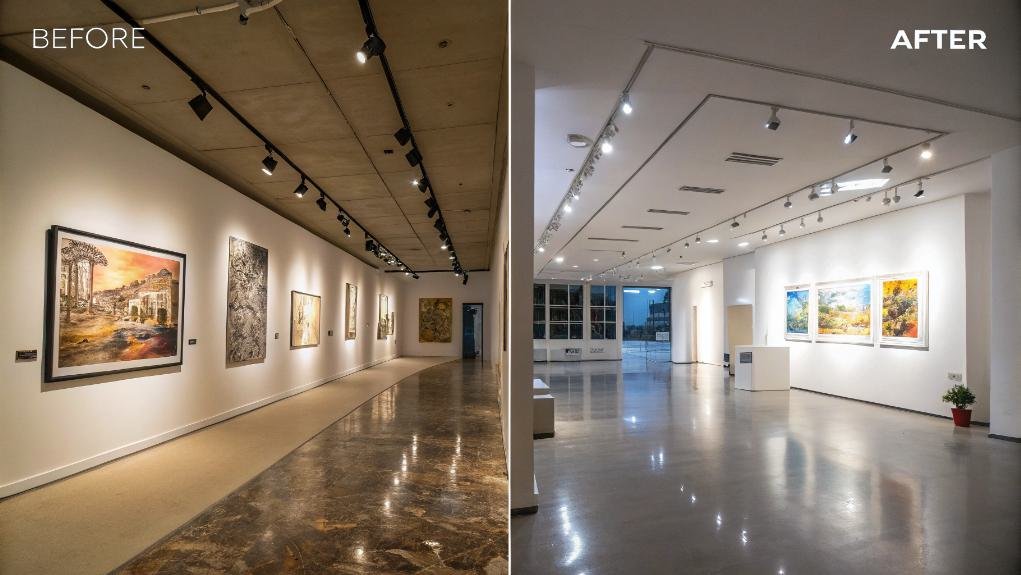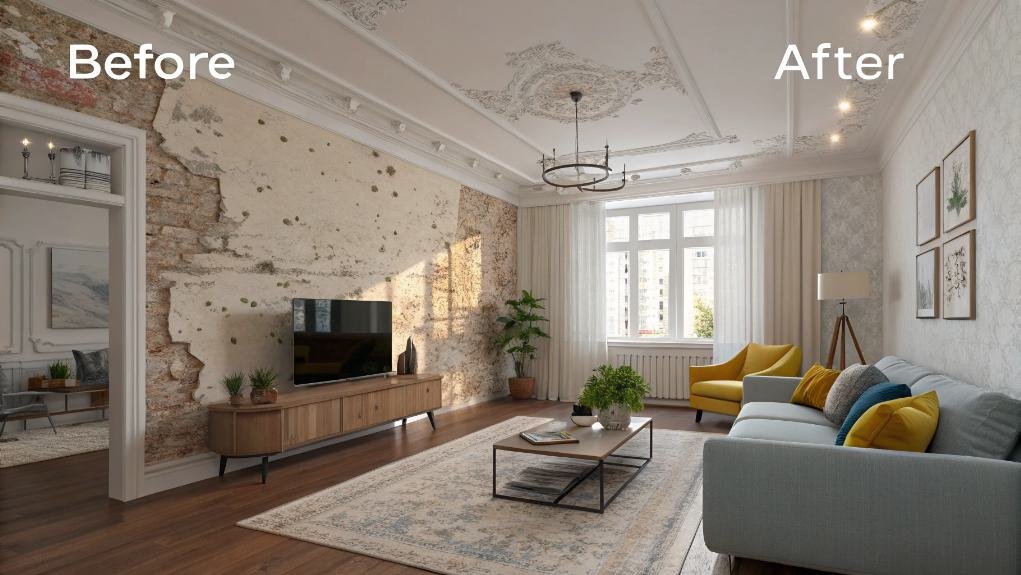Leveraging before-and-after photos is a game-changer for SEO and boosting sales. These visuals act as powerful testimonials, showcasing product effectiveness and building trust with potential customers. By optimizing your images with keyword-rich filenames and alt text, you enhance their visibility on search engines. Plus, high-quality images engage your audience, driving more traffic to your site. To maximize impact, guarantee your gallery is well-organized and fresh with diverse content. This approach not only increases user engagement but also enhances your brand's credibility. Want to uncover more strategies to elevate your marketing efforts? There's plenty more to explore!
Key Takeaways
- Optimize before-and-after images with descriptive filenames and alt text to enhance search engine visibility and drive organic traffic.
- Regularly update galleries with fresh, high-quality visuals to maintain audience engagement and improve SEO rankings.
- Use emotional storytelling in captions to connect with potential clients, increasing their likelihood of making a purchase.
- Incorporate lazy loading techniques to improve page load speed, enhancing user experience and reducing bounce rates.
- Leverage social proof by showcasing successful transformations, building trust, and encouraging potential customers to choose your services.
Importance of Before-and-After Photos

When you're considering an aesthetic provider, before-and-after photos are essential in helping you make an informed decision. They not only showcase the visual impact of treatments but also build client trust.
In fact, 53% of clients find these images the most valuable when selecting a provider. If a practice doesn't display these photos, 83% of potential clients won't even consider them.
Before-and-after images serve as proof that the services work, documenting each client's journey while highlighting successful results. High-quality photos can inspire you to take action, showing attainable outcomes. Additionally, these images are crucial for establishing trust and credibility in the aesthetic field.
Effective SEO Techniques

To boost your SEO with before-and-after photos, you need to focus on keyword optimization and image tagging best practices. Use descriptive filenames and alt text to help search engines understand your images while improving accessibility. Additionally, optimizing your images for mobile-friendly content formats ensures a better user experience, which can positively impact your search rankings.
Keyword Optimization Strategies
Keyword optimization strategies are essential for boosting your website's visibility and attracting the right audience. Start with thorough keyword analysis to understand your target audience's needs. Conduct competitor research to identify gaps and opportunities in your market. Utilize tools like Google Suggest and Semrush to find relevant keywords and assess competition levels. Keyword optimization drives high-quality traffic and boosts SERP rankings, making it a vital component of your SEO efforts.
| Step | Action | Tools |
|---|---|---|
| Understand Audience | Research keyword needs | Google Trends |
| Analyze Keywords | Evaluate competition | Semrush, Ubersuggest |
| Optimize Content | Integrate keywords | Yoast SEO |
Image Tagging Best Practices
Images are an essential component of your website, not just for visual appeal but also for enhancing your SEO strategy. To maximize your image relevance, start by using accurate and unique tags that reflect the content. Leverage tagging tools to streamline the process, ensuring you maintain consistency across all images. Implementing image title tags can significantly improve user engagement and accessibility, making your content more informative. Avoid unnecessary details that could confuse search engines; instead, focus on concise, contextual information. Utilizing AI-powered tagging solutions can speed up your workflow, but always review for accuracy. Don't forget to implement structured data and descriptive title tags, as these enhance search engine understanding.
Best Practices for Galleries

When it comes to your galleries, organizing your images with descriptive titles can make a world of difference in attracting visitors. Additionally, incorporating high-quality visuals can enhance user engagement and significantly contribute to your website traffic. Don't forget to use keyword-based tags to improve your searchability and reach your target audience effectively. Plus, incorporating diverse content types keeps your gallery engaging and showcases the full spectrum of your work.
Organize With Descriptive Titles
Crafting descriptive titles for your galleries is essential not only for engaging your audience but also for enhancing the overall effectiveness of your SEO strategy. Titles can differentiate images in contests, galleries, and exhibitions, making them essential for viewer engagement. Follow gallery title guidelines that keep it simple and relevant. Use descriptive title examples that provide context without overwhelming viewers. Avoid keyword stuffing; instead, incorporate relevant keywords naturally. For instance, include location names or dates to add historical context.
Highlight relationships within your images to create intriguing narratives. Consistency is key—maintain a uniform format across your titles.
Use Keyword-Based Tags
Effective use of keyword-based tags can greatly enhance your gallery's SEO performance. Start by prioritizing targeted keywords in your image titles and descriptions, ensuring high keyword frequency. Don't forget to include long-tail keyphrases that capture specific search queries, as this helps attract a more targeted audience. Tagging consistency is essential; keep your naming conventions uniform across all images to improve recognition by search engines. Use descriptive alt text and keyword-rich file names, which provide additional context and boost visibility. Regularly update your tags to align with evolving search trends, and integrate keywords naturally into your content. Additionally, remember that meta keywords are no longer a primary ranking factor, so focus on content quality and user intent for optimal SEO results.
Incorporate Diverse Content Types
To truly maximize your gallery's potential, incorporating diverse content types is key. By mixing images with engaging narratives, you create a richer experience for your audience.
Use a variety of formats—like high-quality photos, infographics, and illustrations—to appeal to different viewers and enhance SEO. Make sure to accompany your images with concise captions and context to boost user engagement. Additionally, incorporating visual content can significantly enhance user experience and increase time spent on your site.
Highlight diverse subjects, such as varying age groups and ethnicities, to resonate with a broader audience. Regularly update your gallery like a blog, using SEO-friendly titles and descriptions.
Don't forget to integrate schema markup to help search engines understand your content better. Ultimately, a diverse gallery keeps visitors coming back for more!
Psychological Effects on Customers

When you see before-and-after photos, it's not just a visual experience; it's an emotional journey that can greatly influence your perception and decision-making.
These images provide tangible evidence of results, acting as social proof that others have achieved similar transformations. As you relate to these stories, your confidence in a product or service grows, directly impacting your buying behavior. You begin to visualize yourself achieving similar outcomes, making the decision to purchase feel more attainable. Additionally, the impact of visual proof drives credibility and encourages you to trust the effectiveness of the treatment.
However, it's crucial to guarantee these photos set realistic expectations. Authenticity matters; idealized images can harm self-esteem and skew customer perception.
Visual Optimization Methods

While showcasing before-and-after photos can greatly enhance your marketing strategy, optimizing these visuals is crucial for maximizing their impact. You should focus on image enhancement techniques, using deep learning models to improve the quality of your photos. Tools that employ smart compression techniques, like Squoosh or Optimizilla, can considerably reduce file sizes without sacrificing quality. Consider modern formats such as WebP or AVIF for better compression and visual appeal. Implement lazy loading to guarantee your page loads quickly, keeping visitors engaged. Remember to add alt text and SEO-friendly titles to help search engines properly index your images. Properly optimized visuals can lead to higher search engine rankings, which is essential for driving more traffic to your site. These visual optimization methods won't only elevate your marketing efforts but also improve your SEO, driving more traffic and sales.
Benefits of Unique Images

Unique images can considerably elevate your website's appeal and effectiveness. By incorporating original visuals, you engage users through creative storytelling that captivates attention and enhances your brand's identity.
Unlike generic stock photos, unique images set you apart from competitors, making your site more memorable. This distinctiveness not only enriches user experience but can also lead to increased dwell time and lower bounce rates, positively influencing your SEO.
Additionally, unique images can boost user-generated content, as visitors are more likely to share and link back to authentic visuals. By investing in unique images, you convey professionalism and authenticity, ultimately driving traffic and conversions while building trust with your audience.
Don't underestimate their power in your marketing strategy!
Integrating Photos in Marketing

Incorporating photos into your marketing strategy can greatly elevate your brand's presence and engagement.
To effectively integrate visuals, consider these key steps:
- Maintain photo consistency across all platforms to strengthen visual branding.
- Use high-quality images in emails and blog posts to boost reader interest and understanding.
- Leverage product photos in social media ads and landing pages for a compelling customer connection.
- Craft visual narratives that guide viewers through your message, enhancing emotional engagement.
